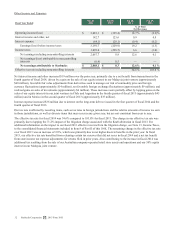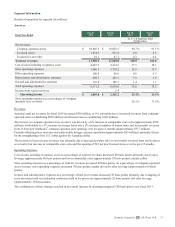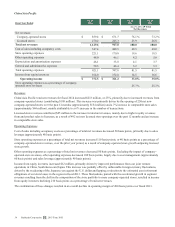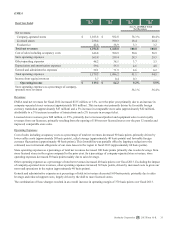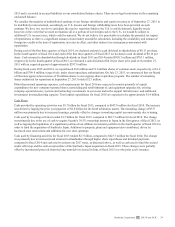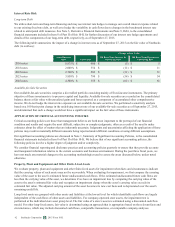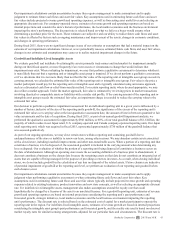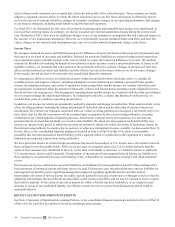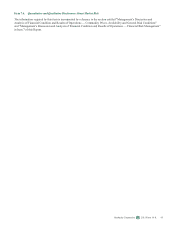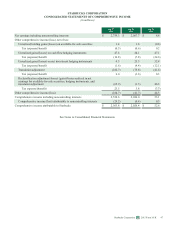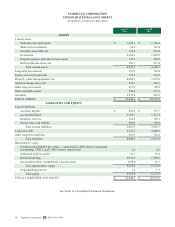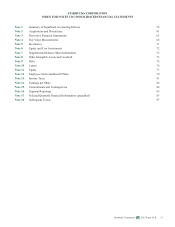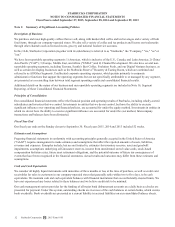Starbucks 2015 Annual Report Download - page 46
Download and view the complete annual report
Please find page 46 of the 2015 Starbucks annual report below. You can navigate through the pages in the report by either clicking on the pages listed below, or by using the keyword search tool below to find specific information within the annual report.
Interest Rate Risk
Long-term Debt
We utilize short-term and long-term financing and may use interest rate hedges to manage our overall interest expense related
to our existing fixed-rate debt, as well as to hedge the variability in cash flows due to changes in the benchmark interest rate
related to anticipated debt issuances. See Note 3, Derivative Financial Instruments and Note 9, Debt, to the consolidated
financial statements included in Item 8 of Part II of this 10-K for further discussion of our interest rate hedge agreements and
details of the components of our long-term debt, respectively, as of September 27, 2015.
The following table summarizes the impact of a change in interest rates as of September 27, 2015 on the fair value of Starbucks
debt (in millions):
Change in Fair Value
Stated Interest
Rate Fair Value
100 Basis Point Increase in
Underlying Rate
100 Basis Point Decrease in
Underlying Rate
2016 notes 0.875% $ 400 $ (5) $ 5
2018 notes 2.000% $ 354 $ (11) $ 11
2022 notes 2.700% $ 503 $ (31) $ 31
2023 notes 3.850% $ 790 $ (54) $ 54
2045 notes 4.300% $ 355 $ (61) $ 61
Available-for-Sale Securities
Our available-for-sale securities comprise a diversified portfolio consisting mainly of fixed-income instruments. The primary
objective of these investments is to preserve capital and liquidity. Available-for-sale securities are recorded on the consolidated
balance sheets at fair value with unrealized gains and losses reported as a component of accumulated other comprehensive
income. We do not hedge the interest rate exposure on our available-for-sale securities. We performed a sensitivity analysis
based on a 100 basis point change in the underlying interest rate of our available-for-sale securities as of September 27, 2015,
and determined that such a change would not have a significant impact on the fair value of these instruments.
APPLICATION OF CRITICAL ACCOUNTING POLICIES
Critical accounting policies are those that management believes are both most important to the portrayal of our financial
condition and results and require the most difficult, subjective or complex judgments, often as a result of the need to make
estimates about the effect of matters that are inherently uncertain. Judgments and uncertainties affecting the application of those
policies may result in materially different amounts being reported under different conditions or using different assumptions.
Our significant accounting policies are discussed in Note 1, Summary of Significant Accounting Policies, to the consolidated
financial statements included in Item 8 of Part II of this 10-K. We believe that of our significant accounting policies, the
following policies involve a higher degree of judgment and/or complexity.
We consider financial reporting and disclosure practices and accounting policies quarterly to ensure that they provide accurate
and transparent information relative to the current economic and business environment. During the past three fiscal years, we
have not made any material changes to the accounting methodologies used to assess the areas discussed below, unless noted
otherwise.
Property, Plant and Equipment and Other Finite-Lived Assets
We evaluate property, plant and equipment and other finite-lived assets for impairment when facts and circumstances indicate
that the carrying values of such assets may not be recoverable. When evaluating for impairment, we first compare the carrying
value of the asset to the asset’s estimated future undiscounted cash flows. If the estimated undiscounted future cash flows are
less than the carrying value of the asset, we determine if we have an impairment loss by comparing the carrying value of the
asset to the asset's estimated fair value and recognize an impairment charge when the asset’s carrying value exceeds its
estimated fair value. The adjusted carrying amount of the asset becomes its new cost basis and is depreciated over the asset's
remaining useful life.
Long-lived assets are grouped with other assets and liabilities at the lowest level for which identifiable cash flows are largely
independent of the cash flows of other assets and liabilities. For company-operated store assets, the impairment test is
performed at the individual store asset group level. The fair value of a store’s assets is estimated using a discounted cash flow
model. For other long-lived assets, fair value is determined using an approach that is appropriate based on the relevant facts and
circumstances, which may include discounted cash flows, comparable transactions, or comparable company analyses.
42 Starbucks Corporation 2015 Form 10-K


